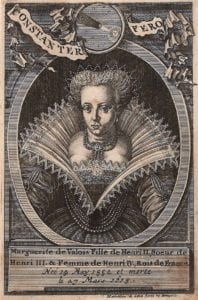Memoires de la Reyne Marguerite, by Marguerite de Valois and Auger de Mauléon. Brussels: F. Foppens, 1658.
Call Number: SpC. 944.031092 M331mr1658
A full-text version of this volume may be viewed here.
As far as we can tell, the young Vincent de Paul arrived in Paris by late 1609 or early 1610 and took up a position as one of the chaplains in the household of Queen Marguerite de Valois. The Queen was one of the daughters of King Henry II of France and Catherine de’ Medici, and sister to three French kings: Francis II, Charles IX, and Henry III. From 1572 until 1599 she was married to the Protestant Henry of Navarre as he struggled to win the French throne. Her marriage to Henry (eventually crowned King Henry IV of France) was childless, and since the new Bourbon King desperately desired an heir their union was annulled in 1599. Henry IV quickly married Marie de’ Medici and produced an heir he needed to secure the dynasty: the future Louis XIII. Marguerite spent the last sixteen years of her life living in her Left Bank palace in Paris.

Marguerite de Valois
Both Louis Abelly and Pierre Coste portray Vincent de Paul’s three years of service to the queen as a key period of conversion in the life of the saint. According to their accounts, this period saw Vincent being publicly accused of theft of by a roommate, his temptation against faith, and his service to the sick-poor at the charity hospital not far from the queen’s palace. Contemporary historiography has raised serious doubts about these accounts. In 1613, Vincent de Paul left the queen’s service and entered into service to the powerful ducal family of Philippe-Emmanuel de Gondi, Duke de Retz. Marguerite of Valois died in Paris at the age of 61 on 27 March 1615.
Marguerite as a Valois princess and as the wife of Henry of Navarre was a witness to, and played a central role in, the last phases of France’s long religious wars and the struggle for succession. At times she was a pawn in the struggles (she was held under house arrest by her brother Henry III for eighteen years), while at others she was an independent actor. She was an intelligent, articulate, beautiful, stylish, and highly literate princess who was simultaneously worldly and conventionally pious. Her historic role and accomplishments have always been under-appreciated because of the double-standards of historiographic misogyny.
The present work is a 1658 edition of her famous memoirs, first published in 1628. The work traces her life up to 1582 and is filled with fascinating insider details of the royal and political struggles of the period. The volume proved very popular and quickly went through many editions in Vincent’s lifetime.